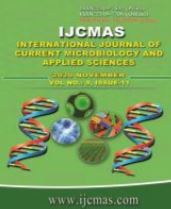


 National Academy of Agricultural Sciences (NAAS)
National Academy of Agricultural Sciences (NAAS)

|
PRINT ISSN : 2319-7692
Online ISSN : 2319-7706 Issues : 12 per year Publisher : Excellent Publishers Email : editorijcmas@gmail.com / submit@ijcmas.com Editor-in-chief: Dr.M.Prakash Index Copernicus ICV 2018: 95.39 NAAS RATING 2020: 5.38 |
The field experiment included nine treatment combinations with two fertilizer levels to intercrop as main plot (F1 - 50 % and F2 - 100 % RDF to intercrop) and four N:P ratios to pigeonpea as sub plots [L1 – 1:2 (25:50 kg N:P2O5 ha-1), L2 – 1:2.5 (25:62.5 kg N:P2O5 ha-1), L3 – 1:3 (25:75 kg N:P2O5 ha-1) and L4 – 1:3.5 (25:87.5 kg N:P2O5 ha-1)] and one absolute control (without any fertilizer application to both the crops). Non- significant difference was noticed in nutrient status of soil with respect to different fertilizer levels to intercrop. Among the N:P ratios to pigeonpea, 1:3, 1:3.5 recorded significantly higher available nitrogen, phosphorus and organic carbon (239.72, 241.60 and 45.35, 47.50 kg ha-1 and 0.49, 0.50 %, respectively). Among the interactions, available nitrogen, phosphorus and organic carbon in soil was found significantly higher with 100 % RDF to intercrop with N:P ratio of 1:3.5 (243.20, 49.14 kg ha-1 and 0.52 %, respectively). Agronomic efficiency was found significantly higher with 50 and 100 % RDF to intercrop with N:P ratio of 1:3 and 1:3.5 (7.50,7.57 and 7.93, 7.63, respectively) of the system. Among the interactions, F2L3, F2L4 showed significantly higher PEY, gross and net returns (2537, 2597 kg ha-1, 1,43,971, 1,47,390 ha-1, and 1,02,771, 1,05,566 ha-1, respectively) over others except F1L3, F1L4 and indicated that 50% RDF was enough to intercrop when main crop was supplied with 75 and 100 kg P2O5.
 |
 |
 |
 |
 |